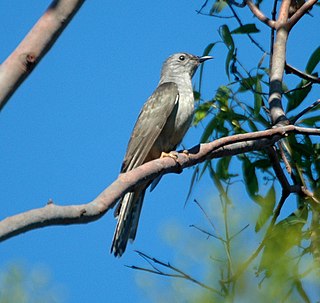
The Sahul brush cuckoo, formerly known as the brush cuckoo, is a member of the cuckoo family. It is native to Malesia, New Guinea, the Solomon Islands and northern and eastern Australia. It is a grey-brown bird with a buff breast. Its call is a familiar sound of the Australian and Indonesian bush.

Phaenicophaeus is a genus of seven species of cuckoos in the family Cuculidae that are found in South and Southeast Asia.

The brown goshawk is a medium-sized bird of prey in the family Accipitridae found in Australia and surrounding islands. This species was formerly placed in the genus Accipiter.

The black-mantled goshawk is a species of bird of prey in the family Accipitridae. It is found in the highlands of New Guinea. Its natural habitat is subtropical or tropical moist lowland forests. This species was formerly placed in the genus Accipiter.

The chestnut-breasted cuckoo is a species of cuckoo in the family Cuculidae. It is found in Australia, Indonesia, and Papua New Guinea. Its natural habitats are subtropical or tropical dry forests and subtropical or tropical mangrove forests.

Cacomantis is a genus of cuckoos in the family Cuculidae. The name is from the Ancient Greek κακομαντις (kakomantis) meaning "prophet of evil". Most species have a round nostril and are mainly in brown and gray colours. The tails are graduated and barred. The bars are transverse in sonneratii and oblique in all others.

The fan-tailed cuckoo is a species of cuckoo in the family Cuculidae. It is found in Australia, Fiji, New Caledonia, New Zealand, New Guinea, Solomon Islands, and Vanuatu.

The Sunda brush cuckoo is a species of cuckoo in the family Cuculidae. It is found in Indonesia, Malaysia, the Philippines, Singapore, and Thailand. Its natural habitat is subtropical or tropical moist lowland forests. It was formerly treated as conspecific with the Sulawesi brush cuckoo with the English name "rusty-breasted cuckoo".
The pied bronze cuckoo is a species of cuckoo in the family Cuculidae. It is found on the Tayandu Islands, the Kai Islands and the Tanimbar Islands, all of which are part of the Maluku Islands in Southeast Asia. It was formerly treated as conspecific with the little bronze cuckoo.
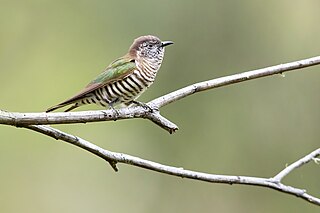
The shining bronze cuckoo is a species of cuckoo in the family Cuculidae, found in Australia, Indonesia, New Caledonia, New Zealand, Papua New Guinea, Solomon Islands, and Vanuatu. It was formerly placed in the genus Chrysococcyx.

The little bronze cuckoo is a species of cuckoo in the family Cuculidae. It was formerly placed in the genus Chrysococcyx. It is found in Southeast Asia, New Guinea and northern and eastern Australia, where its natural habitat is subtropical or tropical moist lowland forest. It is the world's smallest cuckoo, at 17 grams (0.60 oz) and 15 cm (6 in). The subspecies rufomerus is sometimes given specific status. The pied bronze cuckoo was formerly considered to be a subspecies.
Meek's pygmy parrot, also known as the yellow-breasted pigmy parrot, is a species of small parrot in the family Psittacidae. It is endemic to Papua New Guinea.

Goldie's lorikeet is a species of parrot in the family Psittaculidae. It is the only species placed in the genus Glossoptilus. It is found in forest and woodland in New Guinea, primarily at altitudes of 1000–2200 m. It is mostly green with yellowish streaks in the chest area, and a red, blue and purple head. It is a small bird measuring 19 cm in length and weighing 45–60 grams.
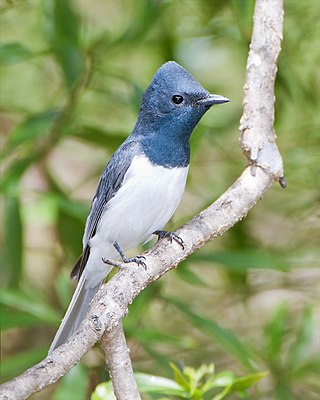
The leaden flycatcher is a species of passerine bird in the family Monarchidae. Around 15 cm (6 in) in length, the male is lustrous azure with white underparts, while the female possesses leaden head, mantle and back and rufous throat and breast. It is found in eastern and northern Australia, Indonesia, and Papua New Guinea. Its natural habitat is subtropical or tropical mangrove forests in the northern parts of its range, in the south and inland it is eucalypt woodland.
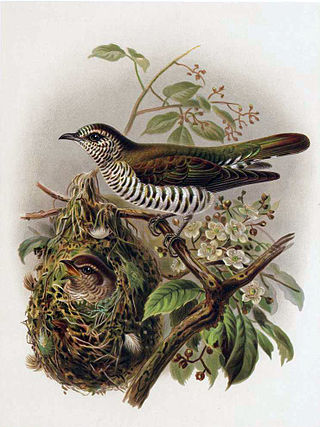
Chrysococcyx is a genus of Australasian cuckoos in the family Cuculidae. They were formerly placed in the genus Chrysococcyx.
The Tukangbesi sunbird is a species of passerine bird in the sunbird family Nectariniidae that is found on the Tukangbesi Islands that lie to the southeast of Sulawesi in Indonesia. It was formerly considered to be a subspecies of the olive-backed sunbird, now renamed the garden sunbird.
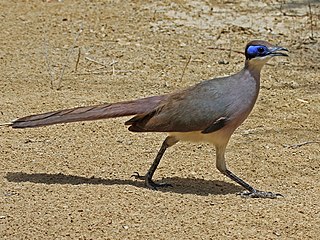
The olive-capped coua is a species of cuckoo in the family Cuculidae. It is endemic to southwest Madagascar.
The Mentawai malkoha is a species of cuckoo in the family Cuculidae. It is endemic to the Mentawai Islands off the west of Sumatra. It was formerly considered to be conspecific with the chestnut-breasted malkoha.
The Sulawesi brush cuckoo is a species of cuckoo in the family Cuculidae. It is found on Sulawesi and some surrounding islands: Banggai Islands, Sula Islands, Butung Island and the Tukangbesi Islands. Its natural habitats are subtropical or tropical moist lowland forests and subtropical or tropical moist montane forests. It is threatened by habitat loss.
The Solomons brush cuckoo is a species of cuckoo in the family Cuculidae. It is found on the Solomon Islands apart from Rennell Island. The species was formerly considered as conspecific with the Sahul brush cuckoo.












